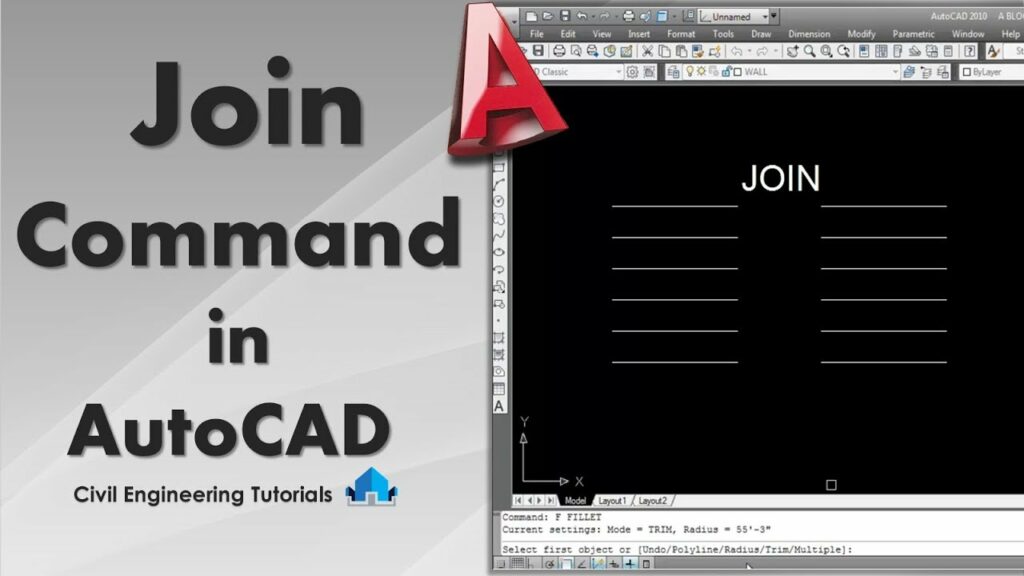Mastering the JOIN Command in AutoCAD: A Comprehensive Guide

AutoCAD, the renowned computer-aided design (CAD) software developed by Autodesk, offers a plethora of powerful tools and commands for creating precise and detailed drawings. Among these tools, the JOIN command stands out as a fundamental feature for connecting and merging objects within a drawing. In this comprehensive guide, we delve deep into the intricacies of using the JOIN command in AutoCAD, exploring various methods, techniques, and best practices for optimal utilization.
Understanding the JOIN Command in AutoCAD:
The JOIN command in AutoCAD allows users to connect and merge individual lines, arcs, polylines, and other geometric entities into a single continuous object. It is a versatile tool for creating closed boundaries, outlines, and shapes by joining separate segments together. The JOIN command enables users to enhance drawing clarity and efficiency by consolidating fragmented geometry into unified entities.
Using the JOIN Command:
AutoCAD offers multiple methods for using the JOIN command to connect objects in drawings:
1. Command Line Input:
The most straightforward method for using the JOIN command is through command line input. To connect objects using the command line, follow these steps:
- Type “JOIN” in the command line and press Enter to activate the JOIN command.
- Select the objects you want to join by clicking on them or selecting them from the drawing area.
- Press Enter to complete the joining operation.
2. Ribbon Interface:
AutoCAD’s Ribbon interface provides a graphical user interface for accessing commands and tools. To use the JOIN command from the Ribbon interface, follow these steps:
- Navigate to the Home tab on the Ribbon.
- Click on the Modify panel to expand it.
- Click on the Join icon to activate the JOIN command.
- Select the objects you want to join.
- Click OK or press Enter to complete the joining operation.
3. Toolbar or Tool Palette:
Users can also access the JOIN command from toolbars or tool palettes for quick access and convenience. Simply click on the Join tool icon in the toolbar or tool palette to activate the JOIN command and follow the prompts to connect objects.
Key JOIN Command Options:
When using the JOIN command in AutoCAD, users can specify various options and parameters to customize the joining operation according to their requirements. Key options include:
- Object Selection: Select the individual lines, arcs, polylines, or other geometric entities you want to join into a single object.
- Close Option: Optionally, enable the close option to automatically close open polylines or polygons by connecting the endpoints, creating closed boundaries.
Advanced Techniques:
In addition to basic joining methods, AutoCAD offers advanced techniques and tools for enhancing the JOIN command and efficiency:
- Joining with Gap Tolerance: Use the JOIN command with a specified gap tolerance to join objects that are close to each other but do not intersect directly, enabling precise joining of fragmented geometry.
- Joining with Object Snaps: Utilize object snaps to accurately select endpoints, midpoints, or other key points for joining objects, ensuring precise alignment and connectivity.
- Joining with Selection Filters: Use selection filters to refine object selection for joining, allowing for targeted joining of specific object types or layers within the drawing.
Best Practices:
To achieve optimal results when using the JOIN command in AutoCAD, it’s essential to adhere to the following best practices:
- Plan and Preview: Before joining objects, carefully review the drawing and plan the desired connections, considering factors such as object relationships and design intent.
- Use Consistent Parameters: Maintain consistency in joining parameters such as object selection and close option to ensure uniformity and accuracy in the joining operation.
- Optimize Object Selection: Select objects efficiently for joining by using selection sets, filters, or object grouping, streamlining the joining operation and minimizing errors.
- Review and Verify: Review joined objects for accuracy and completeness before finalizing drawings, verifying connectivity and boundaries to ensure compliance with design specifications.
Conclusion:
In conclusion, mastering the JOIN command in AutoCAD empowers designers and drafters to connect objects with precision and efficiency. By understanding the various methods, options, and best practices for using the JOIN command, users can consolidate fragmented geometry into unified entities, enhancing drawing clarity and efficiency. With AutoCAD’s versatile tools and features, designers can achieve efficient joining operations and enhance productivity in their drawings and designs.




